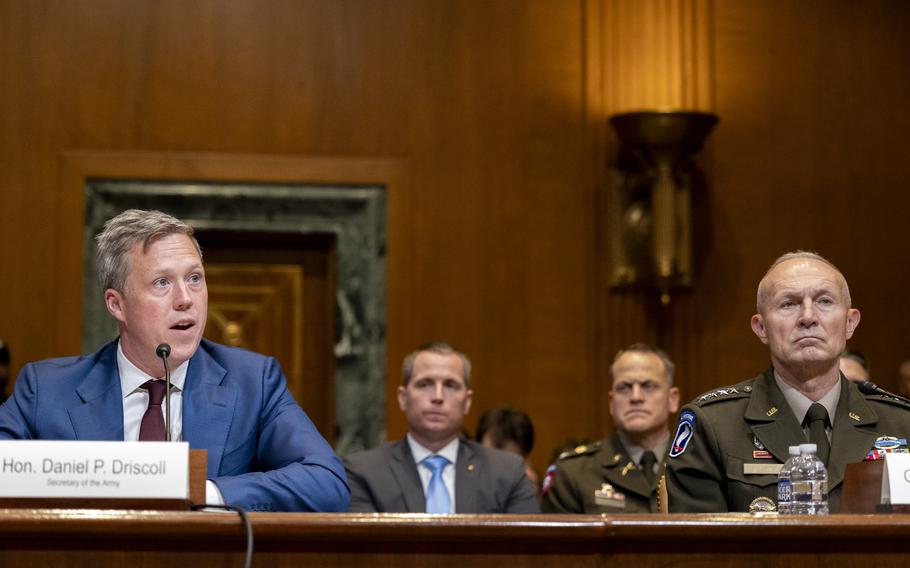
Army Secretary Daniel Driscoll, left, and Army Gen. Randy George, the service’s chief of staff, testify Wednesday, June 18, 2025, during a Senate Appropriations Committee hearing on the Army budget. (Eric Kayne/Stars and Stripes)
WASHINGTON — Army Secretary Dan Driscoll on Wednesday promised senators more information within two weeks on the service’s new force restructuring plan that some lawmakers have said lacks details.
“What we hope you see in 10 days as we explain our changes and the recycling of this $48 billion, this was not intended to simply be a cost-cutting exercise,” Driscoll told members of a subpanel of the Senate Appropriations Committee. “Every dollar is intended to help us innovate and move forward to face threats around the world.”
The restructuring effort called the Army Transformation Initiative, or ATI, announced last month aims at eliminating outdated equipment and shrinking the staffs of unit and command headquarters. The plan was announced in part as a response to Defense Secretary Pete Hegseth orders for the military services to cut their budgets by 8% and eliminate dozens of general officer positions.
The first step of the transformation process was to move some 1,000 soldiers — including general officers — out of headquarters elements and into combat formations. The ATI is part of a plan to prepare soldiers for a battlefield where drones and emerging technologies are expected to dominate.
“We’re going to make changes that we can at our level so that we can continue to dominate,” said Gen. Randy George, the service’s chief of staff.
To date, the Army has announced the initiative seeks to cut some outdated and underperforming vehicles including the decades-old Humvee and the newer Joint Light Tactical Vehicle, as well as cutting the AH-64D Apache attack helicopter in favor of new drones and the state-of-the-art AH-64E model Apache.
“It’s hard for me to say we’re on the right path because I don’t know what path we’re on,” said Sen. Jerry Moran, R-Kan. “I hear what we’re going to reduce. I don’t yet know what we’re going to do to spend.”
The senator added he is concerned the plan is focused on China “while focusing significantly less” on the rest of the world.
Other senators expressed concerns related to failed Army modernization efforts in the past, mothballing munitions-production facilities, cutting the Ripsaw Robotic Combat Vehicle and working under a flat budget.
“I regret that the Army is being tasked with doing more with less. But it’s increasingly likely that looming challenges will test us in multiple theaters simultaneously,” said Sen. Mitch McConnell, R-Ky., the chairman of the subcommittee. “But we can’t expect success on a shoestring budget.”
The Defense Department has not submitted a detailed budget proposal to Congress, which is now later than any budget in recent history. The House Armed Services Committee last week approved a $831.5 billion defense spending bill that keeps the base Pentagon budget flat for fiscal 2026, which begins Oct. 1.
The Army’s budget for 2025 was $185.9 billion.
“We can use our current budget and transform the Army as long as we’re able to spend it the way that we believe is right,” Driscoll said.
Driscoll and George also reiterated the Army is meeting its active duty recruiting goal for this month, marking the earliest the service has reached its annual enlistment target in more than a decade. Driscoll said the service is on track to fill 20,000 contracts for the Delayed Entry Program for fiscal 2026.